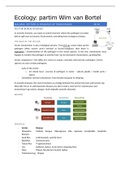Ecology: partim Wim van Bortel
MALARIA: VECTORS & DYNAMICS OF TRANMISSION 18/10
VECTOR-BORNE DISEASES
In zoonotic diseases, you need an animal reservoir where the pathogen circulates
before spill-over to humans. Environment: everything from ecology to climate..
THE ROLE OF THE VECTOR
Vector transmission is also a biological process. First pick-up: vector takes up the
pathogen (often vectors aren’t infected as larvae/nymphae), then there is
replication / transformation of the pathogen in the vector species. In the end, transmission must
happen to transfer the pathogen to another host. Eg via mechanical transmission: eg biting flies.
Vector competence = the ability of a vector to acquire, maintain and transmit a pathogen. Certain
species can carry certain pathogens.
- Cycle in the vector:
o Inf. blood meal - journey of pathogen in vector - salivary glands / mouth parts /
faeces
- Sometimes vertical transmission: from female mosquito to offspring
In zoonotic diseases, the vector functions as a bridge between the animal reservoir and humans (eg
West Nile Virus). In anthroponotic diseases you don’t need a reservoir for maintenance and
transmission (eg malaria, dengue: both originally zoonotic diseases).
DRIVERS
EXAMPLES
- Vector Disease
- Mosquitos Malaria, dengue, chikungunya, Zika, Japanese encephalitis, lymphatic
filariasis
- Sand flies Leishmaniasis, sand fly fever
- Blackflies Onchocerciasis
- Tsetse flies Trypanosomiasis
- Lice Epidemic typhus, louse-borne relapsing fever
- Fleas Plaque, flea-borne (murine) typhus
- Triatomine bug Chagas
, - Hard ticks Lyme borreliosis, tick-borne encephalitis, Crimean-Congo haemorrhagic fever
- Snails Schistosomiasis
MOSQUITOS AS VECTOR
TAXONOMY
Mosquitos are diptera: 6 legs and 1 pair of wings (2 wings). Cullicoidea are steekmuggen. Cullicidae
are subdivided in anophelinae and culicinae. Anophelinae conclude the genus anopheles, culicinae
include the genera Culex and Aedes.
Anopheles:
- ~3500 mosquito species & ~465 Anopheles species. Among the Anopheles:
o ~70 species are capable to transmit Plasmodium
o ~40 species are important vectors
Has to do with vector competence but also the species
Anopheles develop from egg to larvae to pupae to adult. Larvae need to air-breath so they are found
at the surface of the water.
A female only has to copulate once and can then produce viable eggs for the rest of her life
(spermatheca). A blood meal is needed for egg development, so only females blood feed. The
gonotrophic cycle takes 2-3 days in tropical situations.
- Anopheles larval breeding sites in an African setting: standing water, breeding sites are
everywhere and man-made.
, - Anopheles larval breeding sites in an Asian setting: breakkish water, open spaces, in
Cambodya in forested areas, shade. In Northern Vietnam: anopheles minimus lives in small
rivers. SO different species have different ecology and larval ecology.
o Anopheles mostly likes clean water, rural areas. The risk on malaria is lower in the
city
BIOLOGY AND ECOLOGY
- Anthropophilic species: prefer to feed on humans
- Zoophilic species: ornithophilic: birds, mammophilic: mammals
- Endophagic: preferably feed indoors - Endophilic: rest outdoors
- Exophagic: preferably feed outdoors - Exophilic: rest outdoors
- Nycthemeral cycle: nocturnal/diurnal/ at dusk & down
o Anopheles are nocturnal; Tiger mosquitos bite during the day
DIVERSITY OF ANOPHELES AND IMPLICATIONS FOR MALARIA EPIDEMIOLOGY
If you try to present the burden of a disease by making the size of the continent
bigger. This is Africa: 90% of malaria cases are reported from Africa.
2 species that cause Malaria:
- Falciparum: primarily in Africa Most life threatening (incubation period 6-
7 D)
- Vivax: primarily in Latin-America and Asia
The 4 plasmodium species are carried by many different mosquitos. The different mosquito species
differ from continent to continent and country to country. Examples: Anopheles gambiae, funestus
and arabiensis in Africa, minimus in Asia, albimanus in central & south America, dirus, minimus and
epiroticus in Southeast Asia.
EXAMPLE 1: UGANDA
In 7 villages mosquitos were collected by human landing collections: identify them & see if they’re
infected by plasmodium. Human landing collections: in 3 houses indoor and outdoor during 6 nights.
The annual entomological inoculation rate (EIR) = BMN x SI. You calculate the number of bites /
man / night estimated by the human landing collections multiplied by infected adults. SI = sporozoite
index. These are the parasites in the salivary glands of the mosquitos that can be transferred to
humans: proportion of mosquitos with sporozoites, estimated from ELISA results.
Graph 1: there is a relationship between the annual EIR and the R 0.
- How many potential infectious bites can a person get during 1
year in a specific village
- In some villages: very large AEIR
- Graph 2: the contribution of the different species to the AEIR:
almost 87% due to Anopheles funestus in Apac.




